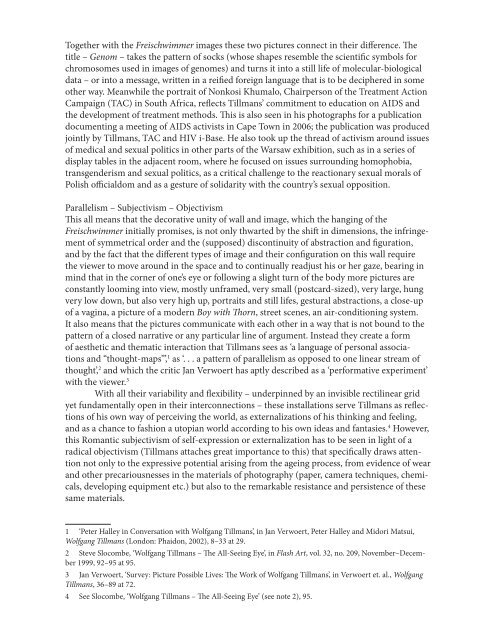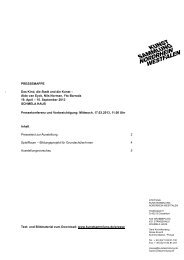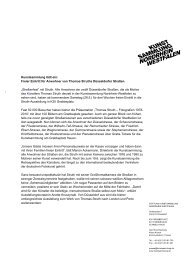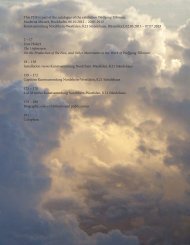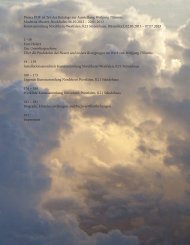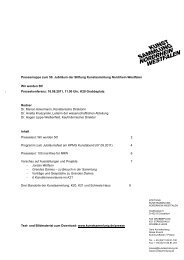Download online catalog (pdf)
Download online catalog (pdf)
Download online catalog (pdf)
You also want an ePaper? Increase the reach of your titles
YUMPU automatically turns print PDFs into web optimized ePapers that Google loves.
Together with the Freischwimmer images these two pictures connect in their difference. The<br />
title – Genom – takes the pattern of socks (whose shapes resemble the scientific symbols for<br />
chromosomes used in images of genomes) and turns it into a still life of molecular-biological<br />
data – or into a message, written in a reified foreign language that is to be deciphered in some<br />
other way. Meanwhile the portrait of Nonkosi Khumalo, Chairperson of the Treatment Action<br />
Campaign (TAC) in South Africa, reflects Tillmans’ commitment to education on AIDS and<br />
the development of treatment methods. This is also seen in his photographs for a publication<br />
documenting a meeting of AIDS activists in Cape Town in 2006; the publication was produced<br />
jointly by Tillmans, TAC and HIV i-Base. He also took up the thread of activism around issues<br />
of medical and sexual politics in other parts of the Warsaw exhibition, such as in a series of<br />
display tables in the adjacent room, where he focused on issues surrounding homophobia,<br />
transgenderism and sexual politics, as a critical challenge to the reactionary sexual morals of<br />
Polish officialdom and as a gesture of solidarity with the country’s sexual opposition.<br />
Parallelism – Subjectivism – Objectivism<br />
This all means that the decorative unity of wall and image, which the hanging of the<br />
Freischwimmer initially promises, is not only thwarted by the shift in dimensions, the infringement<br />
of symmetrical order and the (supposed) discontinuity of abstraction and figuration,<br />
and by the fact that the different types of image and their configuration on this wall require<br />
the viewer to move around in the space and to continually readjust his or her gaze, bearing in<br />
mind that in the corner of one’s eye or following a slight turn of the body more pictures are<br />
constantly looming into view, mostly unframed, very small (postcard-sized), very large, hung<br />
very low down, but also very high up, portraits and still lifes, gestural abstractions, a close-up<br />
of a vagina, a picture of a modern Boy with Thorn, street scenes, an air-conditioning system.<br />
It also means that the pictures communicate with each other in a way that is not bound to the<br />
pattern of a closed narrative or any particular line of argument. Instead they create a form<br />
of aesthetic and thematic interaction that Tillmans sees as ‘a language of personal associations<br />
and “thought-maps”’, 1 as ‘. . . a pattern of parallelism as opposed to one linear stream of<br />
thought’, 2 and which the critic Jan Verwoert has aptly described as a ‘performative experiment’<br />
with the viewer. 3<br />
With all their variability and flexibility – underpinned by an invisible rectilinear grid<br />
yet fundamentally open in their interconnections – these installations serve Tillmans as reflections<br />
of his own way of perceiving the world, as externalizations of his thinking and feeling,<br />
and as a chance to fashion a utopian world according to his own ideas and fantasies. 4 However,<br />
this Romantic subjectivism of self-expression or externalization has to be seen in light of a<br />
radical objectivism (Tillmans attaches great importance to this) that specifically draws attention<br />
not only to the expressive potential arising from the ageing process, from evidence of wear<br />
and other precariousnesses in the materials of photography (paper, camera techniques, chemicals,<br />
developing equipment etc.) but also to the remarkable resistance and persistence of these<br />
same materials.<br />
1 ‘Peter Halley in Conversation with Wolfgang Tillmans’, in Jan Verwoert, Peter Halley and Midori Matsui,<br />
Wolfgang Tillmans (London: Phaidon, 2002), 8–33 at 29.<br />
2 Steve Slocombe, ‘Wolfgang Tillmans – The All-Seeing Eye’, in Flash Art, vol. 32, no. 209, November–December<br />
1999, 92–95 at 95.<br />
3 Jan Verwoert, ‘Survey: Picture Possible Lives: The Work of Wolfgang Tillmans’, in Verwoert et. al., Wolfgang<br />
Tillmans, 36–89 at 72.<br />
4 See Slocombe, ‘Wolfgang Tillmans – The All-Seeing Eye’ (see note 2), 95.


